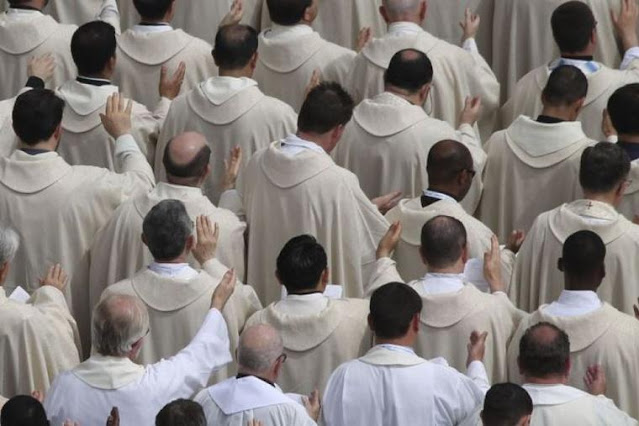 |
| Priests concelebrate a Mass in Rome. (photo: Martha Calderón/ACI Prensa / EWTN) |
Catholic priests may experience periods of crisis within their ministry, encountering complex personal and pastoral challenges shaped by societal changes, individual struggles, and the evolving needs of their communities. While this overview focuses on personal crises, it does not claim to be exhaustive. Here, we’ll explore some common causes of these challenges and offer suggestions to help priests navigate them with resilience and hope.
Reasons Behind the Crisis
Isolation and Loneliness: The life of a priest can sometimes be isolating. Though they are often surrounded by people, the pastoral role can feel solitary, as priests may not always have a close network with whom they can share personal struggles. Pope Francis has remarked on this challenge, saying, “Priestly ministry is hard, sometimes lonely or dangerous work serving the neediest with an open, vulnerable heart." Priests are called to draw strength from their flock and their love for God, rather than seeking rest or escape in “worldly pursuits,” or by isolating themselves in their offices or traveling in cars “with tinted windows” (Homily, Chrism Mass, 2015). Without a supportive community, priests may feel detached from the people they serve and from their fellow clergy.
High Expectations and Burnout: Priests are expected to wear many hats: shepherd, counselor, teacher, administrator, and more. With such high expectations, the risk of burnout is significant, as they may feel pressured to meet every need. Priestly service requires a profound union with Christ. Without it, priests would become mere functionaries who are eventually exhausted by the demands of their roles. Constantly giving without receiving adequate support or spiritual renewal can lead to physical, mental, and spiritual exhaustion.
Crisis of Faith and Purpose: Like many people in any walk of life, priests can experience moments of doubt and questioning, especially when faced with tragedies or when their faith seems to waver under the weight of pastoral responsibilities. Fr. Henri Nouwen reflected on this, writing, “The great task of the minister is to help others affirm a belief in their own existence, yet it is often the minister who struggles most with self-acceptance” (The Wounded Healer, 1979). This “wounded healer” concept emphasizes that priests, too, need pastoral care.
Changing Social Landscape: The modern world presents unique challenges for priests. The rise of secularism, skepticism about religious institutions, and controversial issues within the Church can contribute to a sense of disconnection from society. As one priest noted, “The priest today faces not just a crisis of faith but a crisis of relevance” (American Catholic Priest, 2022). Maintaining a sense of purpose amidst these changes requires deep resilience and adaptation.
Rising Above the Crisis
Establish a Strong Support Network: One of the most crucial steps a priest can take is to foster relationships with fellow clergy, friends, and mentors. Creating a community where they feel safe and supported can help alleviate feelings of loneliness and isolation. Regular check-ins with a spiritual director or trusted advisor are invaluable for ongoing guidance and encouragement.
Prioritize Self-Care and Boundaries: Priests are often so dedicated to their congregations that they neglect their own well-being. A priest is never his own; he belongs to all. But to serve others well, he must first attend to his own soul. Taking time for rest, hobbies, and health can prevent burnout and ensure that they’re able to continue serving with a joyful spirit.
Continual Spiritual Formation: Maintaining a vibrant prayer life and regularly participating in retreats can be transformative for priests. Returning to their original sense of calling and reaffirming their relationship with God can be a powerful remedy for spiritual dryness. Engaging with scripture, theological study, and personal reflection allows priests to deepen their understanding of their vocation.
Engage with the Community Meaningfully: Finding ways to connect with parishioners on a personal level can remind priests of their purpose. Building authentic relationships with parishioners can reignite their passion for ministry and help them feel more integrated into the lives they’re called to serve. Pope Francis encourages priests to “smell like the sheep,” urging them to be close to the people, especially in their times of need (Homily, Chrism Mass, 2013).
Seek Counseling and Therapy When Needed: There is no shame in seeking professional help when dealing with emotional or psychological struggles. Many priests benefit from therapy, where they can process their challenges in a safe environment. As Fr. Richard Rohr observes, “Healing ourselves is the most important thing we can do for our communities” (Breathing Under Water, 2011). By addressing their inner struggles, priests can better serve their communities with empathy and strength.
Remember the Call to Service and Sacrifice: Finally, remembering the essence of the priesthood as a vocation of service and sacrifice can be grounding. Reaffirming the mission—to lead, to love, and to serve—can re-center priests during challenging moments. As they reflect on their call, priests may find new meaning in their journey and rediscover the joy of their ministry.
Epilogue: A priest’s life is one of profound dedication, and while the challenges they face can be daunting, their resilience is a testament to their faith. Through connection, self-care, and ongoing formation, priests can rise above crises and continue to embody the love and hope they bring to the world. As St. Paul reminded Timothy, "Fan into flame the gift of God, which is in you" (2 Timothy 1:6).




.jpeg)
.jpeg)

.jpeg)








.jpeg)